Zwitterion 3 - Study guides, Class notes & Summaries
Looking for the best study guides, study notes and summaries about Zwitterion 3? On this page you'll find 49 study documents about Zwitterion 3.
Page 2 out of 49 results
Sort by
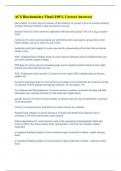
-
ACS Biochemistry Final (100% Correct Answers)
- Exam (elaborations) • 5 pages • 2023
- Available in package deal
-
- $11.49
- + learn more
pKa (chapter 3) correct answers measure of the tendency of a group to give up a proton (acidity); tendency decreases tenfold as pKa increases by one unit thioester bond (1) correct answers compounds with functional group C-S-CoA-C (eg, in acetyl-CoA) zwitterion (3) correct answers dipolar ion with both positive and negative groups but overall neutral charge; can act as either an acid or base Isoelectric point (pI) (chapter 3) correct answers the characteristic pH at which the net electr...
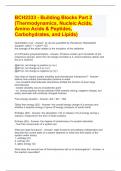
-
BCH2333 - Building Blocks Part 2 (Thermodynamics, Nucleic Acids, Amino Acids & Peptides, Carbohydrates, and Lipids) Q's & A's
- Exam (elaborations) • 13 pages • 2024
-
- $8.99
- + learn more
BCH2333 - Building Blocks Part 2 (Thermodynamics, Nucleic Acids, Amino Acids & Peptides, Carbohydrates, and Lipids) Quantitation of pI - Answer- pI can be quantified by Henderson-Hasselbalch equation: (pKa^-1 + pKa^+1)/2 the average of the pKas relates to the ionization of the zwitterion pI of Proteins (polyampholytes) - Answer- Proteins contain up to hundreds of pH-responsive groups; when the net charge of protein is 0, anions balance cations and the pI is reached @pH<pI, net charg...
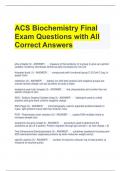
-
ACS Biochemistry Final Exam Questions with All Correct Answers
- Exam (elaborations) • 6 pages • 2023
- Available in package deal
-
- $12.39
- + learn more
ACS Biochemistry Final Exam Questions with All Correct Answers pKa (chapter 3) - ANSWER measure of the tendency of a group to give up a proton (acidity); tendency decreases tenfold as pKa increases by one unit thioester bond (1) - ANSWER compounds with functional group C-S-CoA-C (eg, in acetyl-CoA) zwitterion (3) - ANSWER dipolar ion with both positive and negative groups but overall neutral charge; can act as either an acid or base Isoelectric point (pI) (chapter ...
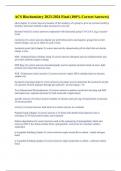
-
ACS Biochemistry 2023-2024 Final (100% Correct Answers)
- Exam (elaborations) • 5 pages • 2023
- Available in package deal
-
- $10.99
- + learn more
pKa (chapter 3) correct answers measure of the tendency of a group to give up a proton (acidity); tendency decreases tenfold as pKa increases by one unit thioester bond (1) correct answers compounds with functional group C-S-CoA-C (eg, in acetyl-CoA) zwitterion (3) correct answers dipolar ion with both positive and negative groups but overall neutral charge; can act as either an acid or base Isoelectric point (pI) (chapter 3) correct answers the characteristic pH at which the net electr...
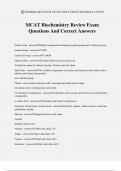
-
MCAT Biochemistry Review Exam Questions And Correct Answers
- Exam (elaborations) • 65 pages • 2024
-
- $12.49
- + learn more
©THEBRIGHT EXAM STUDY SOLUTIONS 8/22/2024 12:54 PM MCAT Biochemistry Review Exam Questions And Correct Answers Amino Acid - answerDipolar compound containing an amino group and a carboxyl group Amino Group - answer-NH2 Carboxyl Group - answer-COOH Alpha Carbon - answerCentral carbon atom in amino acid Attached to amino & carboxyl groups, H atom, and side chain Side Chain - answerThe variable component of an amino acid that gives the amino acid its identity and chemical properties also...
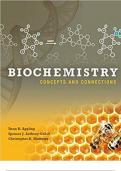
-
Test Bank for Biochemistry Concepts and Connections 1st Edition by Dean R. Appling, Spencer J. Anthony-Cahill & Christopher K. Mathews , ISBN: 9780321839923 |COMPLETE TEST BANK| Guide A+
- Exam (elaborations) • 102 pages • 2024
-
- $10.99
- + learn more
Biochemistry: Concepts and Connections (Appling et al.) Chapter 1 Biochemistry and the Language of Chemistry 1) The water content in the human body is approximately: A) 90%. B) 80%. C) 70%. D) 60%. E) 50%. Answer: C 2) The four most abundant chemical elements in living systems are: A) hydrogen, oxygen, sulfur and phosphorus. B) hydrogen, carbon, nitrogen and oxygen. C) sodium, potassium, carbon and oxygen. D) sodium, potassium, nitrogen and sulfur. E) carbon, nitrogen, oxygen and potassium. Answ...
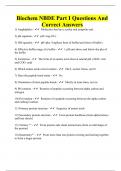
-
Biochem NBDE Part I Questions And Correct Answers
- Exam (elaborations) • 29 pages • 2023
-
- $11.99
- + learn more
1) Amphiphiles - Molecules that have a polar and nonpolar end. 2) pH equation - pH=-log (H+) 3) HH equation - pH=pka +log(base form of buffer/acid form of buffer) 4) Effective buffer range of a buffer - 1 pH unit above and below the pka of the buffer 5) Zwitterion - The form of an amino acid when at neutral pH. (NH3+ end and COO- end) 6) Which amino acids exist in nature - The L isomer forms, not D 7) Does the peptide bond rotate - No 8) Orientation of most pep...
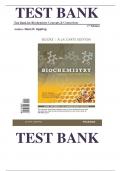
-
Test Bank for Biochemistry Concepts and Connections 1st Edition by Dean R. Appling, Spencer J. Anthony-Cahill & Christopher K. Mathews , ISBN: 9780321839923 |COMPLETE TEST BANK| Guide A+
- Exam (elaborations) • 102 pages • 2024
-
- $19.99
- + learn more
Biochemistry: Concepts and Connections (Appling et al.) Chapter 1 Biochemistry and the Language of Chemistry 1) The water content in the human body is approximately: A) 90%. B) 80%. C) 70%. D) 60%. E) 50%. Answer: C 2) The four most abundant chemical elements in living systems are: A) hydrogen, oxygen, sulfur and phosphorus. B) hydrogen, carbon, nitrogen and oxygen. C) sodium, potassium, carbon and oxygen. D) sodium, potassium, nitrogen and sulfur. E) carbon, nitrogen, oxygen and potassium. Answ...
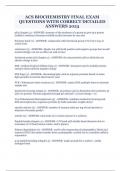
-
ACS BIOCHEMISTRY FINAL EXAM QUESTIONS WITH CORRECT DETAILED ANSWERS 2023
- Exam (elaborations) • 5 pages • 2023
- Available in package deal
-
- $9.99
- + learn more
ACS BIOCHEMISTRY FINAL EXAM QUESTIONS WITH CORRECT DETAILED ANSWERS 2023
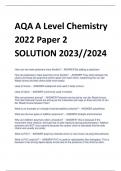
-
AQA A Level Chemistry 2022 Paper 2 SOLUTION 2023//2024
- Exam (elaborations) • 5 pages • 2024
- Available in package deal
-
- $11.49
- + learn more
AQA A Level Chemistry 2022 Paper 2 SOLUTION 2023//2024 How can we make polymers more flexible? - ANSWER By adding a plasticiser How do plasticisers make polymers more flexible? - ANSWER They stick between the chains and keep the polymers further apart from each other, weakening the van der Waals forces and lets chains slide more easily. Uses of Kevlar - ANSWER bulletproof and used in body armour. Uses of Nylon - ANSWER commonly used in textiles. Why are polymers strong? - ANSWER Poly...

How did he do that? By selling his study resources on Stuvia. Try it yourself! Discover all about earning on Stuvia


